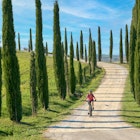
Apr 28, 2025 • 9 min read
Taste wine, see world-class art, and follow in the footsteps of pilgrims with these top experiences in Tuscany.

Apr 28, 2025 • 9 min read
Taste wine, see world-class art, and follow in the footsteps of pilgrims with these top experiences in Tuscany.

Apr 13, 2025 • 10 min read
There's so much to explore in this classic region of Italy, from vineyards and cathedrals to mountains and the sea.

Oct 24, 2024 • 6 min read
Plan your trip to Tuscany with these top tips from a local writer.

Oct 17, 2024 • 5 min read
Tuscany is the Italy many people dream about, but when is the best time to come? Find out with our guide to the best times for a Tuscan escape.

Mar 27, 2024 • 5 min read
Want to travel from Rome to Tuscany on a day trip? Lonely Planet writer, Paula Hardy, tells you how to make that happen.

Aug 19, 2020 • 5 min read
Learning new cookery skills and sightseeing in beautiful Tuscany had a long-lasting impact on this travel blogger.

Oct 18, 2019 • 5 min read
Attention: World Pasta Day is 25 October. All diets are cancelled. Join the celebration by visiting the birthplace of your favourite pasta shapes.

Jul 25, 2019 • 5 min read
Taking your baby away for the first time is a big milestone and choosing the right destination is key to making the trip a success. Unless you are super…

Jul 27, 2018 • 6 min read
A hardened place of rocky outcrops, marshes and undulating hills that abut a dramatic coastline of cliffs and long windswept beaches, the Province of…

Nov 20, 2017 • 6 min read
The Italian region of Tuscany is rightly famous for its outstanding history, culture, wine and cuisine. But there's another side to the region waiting to…

Nov 7, 2016 • 6 min read
Everyone knows Italy – Rome’s iconic ruins, Tuscany’s vine-clad hills, Venice’s romantic waterways. These have all been on traveller's radars for centuries…

Mar 30, 2016 • 5 min read
If Italy can claim Europe’s most tempting cuisine, Tuscany is both its larder and its inspiration. This sun-drenched, vine-lined region is rich in slices…